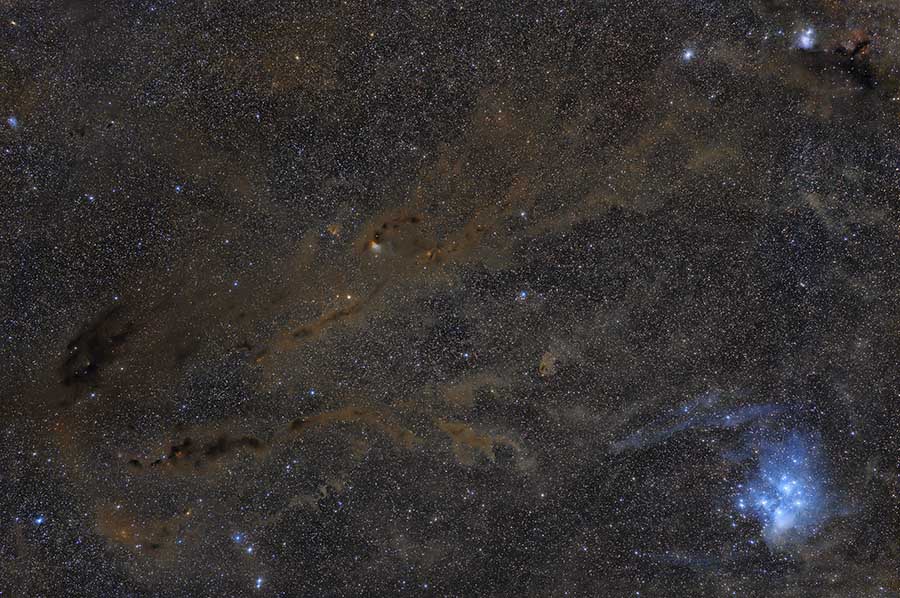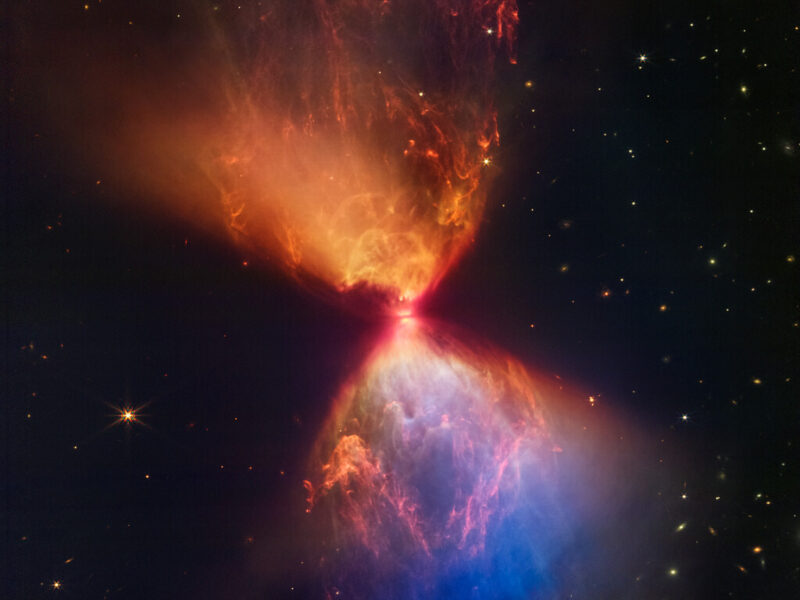Starbirth is dark at visible wavelengths, but the James Webb Space Telescope sees a riot of colors from the warm glow of a feeding infant star.

Tommy Nawratil / S&T Online Photo Gallery
At visible wavelengths, the Taurus Molecular Cloud looks like a dark hole in the sky. The dark nebula of dust and gas, some 450 light-years away to the north of Aldebaran and east of the Pleiades. The dust here is so thick, it blocks the light of the background Milky Way.
But longer wavelengths have pierced that veil to tell a different story. Here is a bustling stellar nursery, one of the nearest to Earth, that’s home to at least 250 infant stars. Now, the James Webb Space Telescope has turned its infrared eyes on one of these protostars, designated L1527, revealing a rainbow of color and detail as we’ve never seen it before.

NASA / ESA / CSA / STScI / J. DePasquale (STScI)
At the center is the not-yet-star, a hot blob of gas that’s only 20% to 40% the Sun’s mass, and thus not yet massive enough to have begun fusion in its core. It is, after all, only about 100,000 years old. It’s still feeding thickly on the cloud around it, which funnels gas and dust into an accretion disk that’s clearly visible as a dark line across the middle of the image. That line is a few hundred astronomical units long, about the size of our solar system. Any planets that might form around this star will still take tens of millions of years to grow.
But as any infant would do, this star doesn’t just feed — it also burps. Those ejections of mass appear as bubble-like shapes in the gas flowing outward above the disk, illuminated by the protostar’s warm glow.
That they’re visible at all is because of previous outflows from the protostar, which cleared out gas and dust above and below the disk. The star’s light suffuses these emptied regions. But dust still veils our view of this region, just some regions less than others. Blue areas have less dust in front of them; light that must traverse more dust on the way to Earth appears orange, “reddening” in the same way a sunset does.
This view represents a look back in time at a star very like our Sun just after it was born.
 5
5









Comments
Lindsay
November 18, 2022 at 7:02 pm
Thanks for this interesting update Monica. Are you saying that the birthing star ejects material from the poles of its rotation axis, which are perpendicular to the accretion disk?
At what stage in a star's development (say for a star the size of our sun) does the polar ejection cease?
You must be logged in to post a comment.
Noam Soker
November 19, 2022 at 3:03 am
The outflow is from the accretion disk in the form of two opposite jets perpendicular to the accretion disk. This is the reason that the two cavities (lobes) are not exactly axial-symmetric, but rather show signatures of precession. Some bipolar planetary nebulae have very similar morphologies. In a planetary nebula a companion (like a main sequence star) to the progenitor accretes mass from the giant progenitor of the planetary nebula. The companion accretes mass through an accretion disk that launches the two opposite jets. In the case of a young stellar object, there is no need for a companion.
You must be logged in to post a comment.
Lindsay
November 19, 2022 at 8:12 am
Thank you for that Noam-Soker. I Googled accretion disk. Apparently the disk itself has orbiting charged particles that create a magnetic field something like the field around a a coil of wire carrying electric current, and it is the magnetic field that forms the polar jet path for ejected matter, but it also has to due with gravitational energy being converted into EMF. I don't understand the math, but here is the paper I found: https://iopscience.iop.org/article/10.1088/1361-6587/aa85f9/pdf.
You must be logged in to post a comment.
Monica YoungPost Author
November 21, 2022 at 9:07 am
Lindsay, that's almost right - as Noam mentioned, the ejection comes from the accretion disk around the protostar. Eventually, the protostar will begin fusion and shine brightly enough that its radiation pressure will drive away the gas in the disk. How long that takes depends on the mass of the star as it begins fusion. The dust will continue to glom together into planets and smaller bodies like asteroids and comets.
You must be logged in to post a comment.
Brian of DRAA
November 21, 2022 at 9:53 am
Brilliant image, I was unaware proto stars burped out these bubbles; the image made me think of Fermi bubbles. Monica, you wrote “a hot blob of gas that’s only 20% to 40% the Sun’s mass, and thus not yet massive enough to have begun fusion in its core”, I think you meant not yet dense enough as red dwarfs can be less than 10% of a solar mass. Lindsay - a one solar mass star will take about 500,000 years to form a core, via self gravitation, with a temperature greater than 10 million kelvin, which is when hydrogen fusion starts (and then the radiation pressure starts to clean up the neighbourhood by blowing away the plasma and the disk will become proto planets, as Monica said above). This WAS thought to be why gas/ice giants were "always" in the outer orbits, but the WASP telescope is making us rethink that model with all the Hot Jupiters it is finding (Sky and Telescope - October 2022). The sun's core is 15 million K. The red dwarves I mention are slow burners at about 10 million K.
You must be logged in to post a comment.
You must be logged in to post a comment.